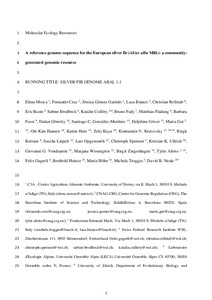Показать сокращенную информацию
A reference genome sequence for the European silver fir (Abies alba Mill.): a community-generated genomic resource
| Автор | Elena, Mosca | |
| Автор | Fernando, Cruz | |
| Автор | Jèssica, Gómez Garrido | |
| Автор | Luca, Bianco | |
| Автор | Christian, Rellstab | |
| Автор | Eric, Bazin | |
| Автор | Sabine, Brodbeck | |
| Автор | Katalin, Csilléry | |
| Автор | Bruno, Fady | |
| Автор | Matthias, Fladung | |
| Автор | Barbara, Fussi | |
| Автор | Dušan, Gömöry | |
| Автор | Santiago C. González-Martínez | |
| Автор | Delphine, Grivet | |
| Автор | Marta, Gut | |
| Автор | Ole, Kim Hansen | |
| Автор | Katrin, Heer | |
| Автор | Zeki, Kaya | |
| Автор | Konstantin V. Krutovsky | |
| Автор | Birgit, Kersten | |
| Автор | Sascha, Liepelt | |
| Автор | Lars, Opgenoorth | |
| Автор | Christoph, Sperisen | |
| Автор | Kristian K. Ullrich | |
| Автор | Giovanni G. Vendramin | |
| Автор | Marjana, Westergren | |
| Автор | Birgit, Ziegenhagen | |
| Автор | Tyler, Alioto | |
| Автор | Felix, Gugerli | |
| Автор | Berthold, Heinze | |
| Автор | Maria, Höhn | |
| Автор | Michela, Troggio | |
| Автор | David B. Neale | |
| Дата внесения | 2020-01-20T08:01:44Z | |
| Дата, когда ресурс стал доступен | 2020-01-20T08:01:44Z | |
| Дата публикации | 2019-07 | |
| Библиографическое описание | Elena, Mosca. A reference genome sequence for the European silver fir (Abies alba Mill.): a community-generated genomic resource [Текст] / Mosca Elena, Cruz Fernando, Gómez Garrido Jèssica, Bianco Luca, Rellstab Christian, Bazin Eric, Brodbeck Sabine, Csilléry Katalin, Fady Bruno, Fladung Matthias, Fussi Barbara, Gömöry Dušan, Santiago C. González-Martínez, Grivet Delphine, Gut Marta, Kim Hansen Ole, Heer Katrin, Kaya Zeki, Konstantin V. Krutovsky, Kersten Birgit, Liepelt Sascha, Opgenoorth Lars, Sperisen Christoph, Kristian K. Ullrich, Giovanni G. Vendramin, Westergren Marjana, Ziegenhagen Birgit, Alioto Tyler, Gugerli Felix, Heinze Berthold, Höhn Maria, Troggio Michela, David B. Neale // Genes Genomes Genetics G3. — 2019. — Т. 9 (№ 7). — С. 2039-2049 | |
| URI (для ссылок/цитирований) | https://www.g3journal.org/content/9/7/2039 | |
| URI (для ссылок/цитирований) | https://elib.sfu-kras.ru/handle/2311/129593 | |
| Аннотация | Silver fir (Abies alba Mill.) is widespread in Central, Eastern and Southern Europe. In Southern Europe, its distribution has increased overall during the 20th century due to land-use change and recolonization from refugial, over-logged populations. During recent decades, its distribution has decreased in most of its distributional range, mainly due to extreme temperature events, forest management practices and ungulate browsing. To forecast its future distribution and survival, it is important to investigate the genetic basis of its adaptation to environmental change, notably extreme events. Here, we provide a first draft genome assembly and annotation of the silver fir genome. DNA obtained from haploid megagametophyte and diploid needle tissue was used to construct and sequence Illumina paired-end (PE) and mate-pair (MP) libraries, respectively, to high depth. The assembled A. alba genome sequence accounted for over 37 million scaffolds corresponding to 18.16 Gb, with a scaffold N50 of 14,051 bp. Despite the fragmented nature of the assembly, a total of 50,757 full-length genes were functionally annotated in the nuclear genome. The chloroplast genome was also assembled into a single scaffold (120,908 bp) that shows a high collinearity with both the A. koreana and A. sibirica complete chloroplast genomes. This first genome assembly of silver fir is an important genomic resource that is now publicly available in support of a new generation of research. By genome-enabling this important conifer, this resource will be opening the gate for new experiments and more precise genetic monitoring of European silver fir forests. | |
| Тема | Abies alba | |
| Тема | annotation | |
| Тема | conifer genome | |
| Тема | genome assembly | |
| Тема | genomic resource | |
| Название | A reference genome sequence for the European silver fir (Abies alba Mill.): a community-generated genomic resource | |
| Тип | Journal Article | |
| Тип | Journal Article Preprint | |
| Страницы | 2039-2049 | |
| ГРНТИ | 34.15.23 | |
| Дата обновления | 2020-01-20T08:01:44Z | |
| DOI | 10.1534/g3.119.400083 | |
| Институт | Институт фундаментальной биологии и биотехнологии | |
| Подразделение | Базовая кафедра защиты и современных технологии мониторинга лесов | |
| Журнал | Genes Genomes Genetics G3 | |
| Квартиль журнала в Scopus | Q1 | |
| Квартиль журнала в Web of Science | Q2 |

